    |
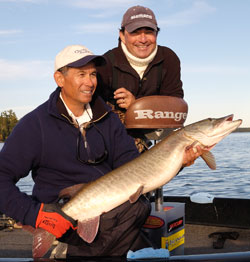 |
Muskie anglers are decidedly different than their quarry. Muskie anglers are typically zealots. Passionate, keen and devoted. Some might say obsessive, compulsive and neurotic. Unlike bass and walleye anglers, for instance, muskie anglers rarely measure a day’s success by the number of fish they catch. Instead, they consider it time well spent if they raise a good fish or entice one to follow their lures.
Though they may catch nothing for days on end, muskie anglers keep their spirits high knowing they may catch a world record fish on their very next cast. Indeed, it is what most expect to do and why they remain forever optimistic.
Muskies, on the other hand, are undeniably moody. Everything seems to bother them. The wind, weather, water conditions, time of day, even the position of the sun and the moon. Oh, sure, occasionally each season when the stars line up just right, you’ll find the fish in a cooperative frame of mind. Muskie madness the old timers use to call it. But it happens less than five percent of the time.
More typically, at least 50-percent by my reckoning, you’ll find the fish in a funk. Grumpy, miserable and down in the dumps. Either you play the game by their rules or they take the ball and go home. The rest of the time, they’re only slightly less depressed.
Fortunately, the very thing that makes muskies so hard to catch, their violent mood swings, also makes them vulnerable. When you match your location and presentation to a muskie’s mood, you can often catch it in its own trap. As long as you keep an open mind
If muskies anglers have an Achilles heel, it is due to the fact that most of them are specialists. Muskie anglers also tend to be more single dimensional rather than multi-disciplinary in their approach. And, it is an easy trap to fall into when you count a good day on the water by the number of fish that you raise.
With action typically at a premium, it’s perhaps understandable that many muskie anglers will start the day casting or trolling a favorite lure and end it twelve hours later, doing exactly the same thing. If they make any change at all, it’s usually subtle like the color of their bait.
There is something else peculiar to many muskie anglers: they often fish with lures that are too big. Especially, in the spring and early summer when even the biggest fish show a decided preference for moderate size forage, and in the heat of summer, when the water is slick and calm. Then, a big muskie can slide in behind an obese bait, look it over carefully, detect the flaws and slip away at the side of the boat without ever hitting it.
Indeed, the high percentage of muskies that anglers see following their lures is testament, I believe, to a flaw in their lure selection process. Is it any wonder muskies are known as “the fish of ten-thousand casts”?
 |
For this reason, most muskie anglers would be well advised to select their lures using the same strategy their financial adviser would suggest to invest their money. Concentrate on quality and diversity.
For some strange reason, however, diversity seems to confuse most anglers. I am always amazed, for example, when I look into a muskie anglers’ tackle box and see row after row of lures that do the same job or cover the same depth. That is numbers, not diversity. For muskies, you first need lures like the LUCKY CRAFT Sammy 128, Live Sammy 120 and Gunfish 115 that let you work the surface in shallow water as well as out over deep breaklines.
You also need lures to strain the water column efficiently and effectively. Baits that closely match the size, shape, color and profile of the baitfish in your favorite waters. For this purpose, I give the nod to the LUCKY CRAFT Flashminnow 130 MR, Live Flashminnow 120 MR, Slender Pointer 127, Real California Premium and Live Pointer 110BB and 110 MR.
Last but not least, you need a tool like the Lucky Craft LVR D-15 that combines a powerful vibrating action with super realistic finishes letting you quickly probe and comb water down as deep as 15-feet.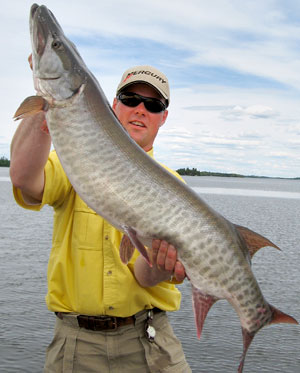 |
But there is an additional benefit that each of these Lucky Craft lures gives you. Something that is missed by all but the most savvy of anglers.
I’ve been chasing muskies now for almost half a century. In the mid-1990s I won the Molson Big Fish contest releasing the biggest muskie in Ontario, Canada. Two years later I caught and released my personal best muskie ever – a gargantuan 57.5-pound monster that was only 8-pounds shy of a new world record.
Throughout this period, I’ve noticed a startling trend. Thirty years ago, I hooked at least 75-percent of my fish during the cast. I nabbed the remaining 25-percent after I spotted a fish following my lure and then worked the bait alongside the boat tracing out a wide oval or the letter-8. (See Side Bar - Catch the Followers). Today, those numbers are almost reversed.
It is testament to the wise catch-and-release trophy management regulations that have been exacted in most marquee muskie waters. Indeed, in many of the most famous systems, places like Leech Lake in Minnesota, the St. Lawrence River in New York and Eagle Lake, Lake of the Woods, Georgian Bay and Lac Seul in Ontario, the minimum muskie size limit is 54-inches.
These prodigious minimum size limits have created phenomenal fisheries but they’ve also served to educate the fish. Indeed, it is likely that the very biggest fish have been caught and released at least once in their lifetime and often two or more times. So, they inspect a bait with the care of a diamond cutter before biting down on it. It is why I like to tell the folks who muskie fish with me, that the day a big toothy critter learns how to avoid eating a LUCKY CRAFT lure, it will stop eating baitfish and starve to death. That is how realistic they look in the water. And why they’re the perfect follow up presentations.
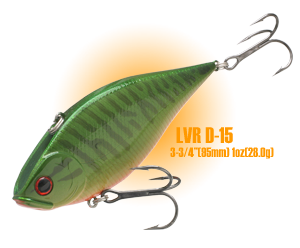 |
Indeed, catching the fish of a lifetime is never an easy task which is why I like throwing Lucky Craft lures in places where most anglers pitch more traditional muskie baits. Like a large cabbage, coontail or hydrilla bed growing along a shallow shoreline, in the back end of cove or bay, or at the mouth of inflowing creek, stream or river.
The choicest salad bars, however, are the ones you find on structure. Like the weeds that flourish on underwater points, offshore reefs and saddles tucked between islands.
The best beds also aren’t uniformly thick and choked with vegetation. They offer plenty of feeding lanes, back alleys and hidden passageways. They are also twisting, turning and ragged. Especially the outside deep, inside shallow and top weed lines.
When I first begin fishing a weedbed like this, I like to quickly walk-the-dog using a LUCKY CRAFT Sammy 128 or Live Sammy 120. When the fish are active, they’ll grab these lures in a swirl that looks and sounds for all the world like a toilet flushing.
After working the surface, I’ll check the weed lines and edges by ripping and twitching a LUCKY CRAFT jerkbait like the Flashminnow 130 MR, Live Flashminnow 120 MR, Slender Pointer 127, Live Pointer 110BB and 110 MR.
Early in the season, when the water is cool and the fish are recovering from spawning, a moderate five to ten second pause is perfect. But when the water is warm and the fish are more active, you want to rip the jerkbait continuously, hesitating briefly for only a second or two. In fact, I like to assume that a big toothy critter is pursuing my lure and when I pause it briefly, the fish overtakes the bait and eats it instinctively.
Other times, I’ll rip a LUCKY CRAFT Flashminnow or Pointer aggressively, then push my rod tip back toward the lure, throwing slack into the line, so the jerkbait swings around like a mouse being chased by a cat, defending itself at the last moment.
The nice thing about using LUCKY CRAFT lures for big trophy muskies, in addition to their lifelike finishes and the fact the fish haven’t become conditioned to seeing them, is that you don’t require specialized tackle to fish them. As a matter of fact, you can rely upon your heavy action bass equipment. I favor 7’ 6” to 8-foot long heavy action Shimano Crucial and Compre baitcasting rods teamed with Chronarch and Calcutta reels spooled with either 80-pound Spiderwire braid or 20-pound test Maxima Ultra-Green monofilament line. It is what I was using when I landed the 57-pounder. And I always use one of the ultra-thin, invisible, titanium wire leaders made by Stringese Tackle or make my own leader using 20-pound test Surflon Micro Supreme knottable stainless steel wire made by American Fishing Wire.
With this set up you can confidently develop a top to bottom coverage system using the world’s most life-life lures. And you’ll be amazed at how many more muskies you’ll not only see, but catch.
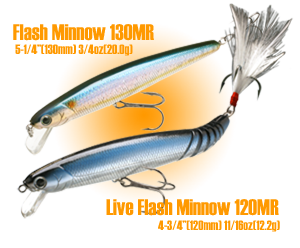  |
Catch the Followers
Muskies see so many lures these days, that if you don’t catch the followers – the magical muskies chasing your bait to the side of the boat – you often won’t catch anything. Ryan Haines (ryan@lakeofthewoodsguide.com) is a top muskie stick on Ontario’s famous Lake of the Woods and he has made an art of turning lookers into hookers.
Haines focuses on his Lucky Craft lure - cast after cast after cast - from the minute it splashes down until he hauls it out of the water for his next pitch. “You can’t expect a follow on every cast,” Haines says, “but you have to be prepared for the times that it happens. So, an important part of your casting routine should be a modified “figure-eight” at the end of every cast.”
To do this, Haines dips his rod tip into the water and swings his lure parallel to the boat at the end of every cast. If he doesn’t spot a fish behind it, in one fluid motion he begins his next cast. But if he spots a muskie behind or below his lure he immediately swings it into a true and proper figure eight.
Actually, “figure-eight” is a misnomer these days. A wide circular oval is a much better pattern. In any event, when you spot a muskie following your Lucky Craft lure, neither speed up nor slow down the pace of your bait. Both are turn offs. Instead, get down on your knees and in one smooth motion, dip your rod into the water – half way down to your reel – and keep retrieving your lure until it’s a foot or two from the rod tip. Do this even if you’re using a surface lure like a LUCKY CRAFT Sammy, Live Sammy or Gunfish. Oh yes, and remember to keep breathing. Then swing your tip in wide oval circles, underwater, alongside the boat. Keep your lure moving at the same depth. Don’t speed it up or slow it down. And keep tracing out those wide spacious circles.
A muskie that’s about to gobble your lure will flare its gill plates and snap at your lure like a biting dog. Whatever you do, don’t slow down. You want to make it easy for the muskie to follow, but at the same time, you want to tantalize it by keeping your lure just out of reach at all times.
Oh yes, one more thing to think about. While all this is going on Haines and I both like to hit the free spool buttons on our baitcasting reels. Then, when the muskie lunges and grabs our Lucky Craft lures, we let it swim away about five feet or so before we engage the spool and set the sticky sharp hooks from the opposite direction.
While you can explain in words how to properly execute a figure eight, nothing works quite like some hands-on practical experience. I always have the folks in my boat practice the procedure before we start fishing. Even so, coaching is often not enough. A few years ago, I spotted a gigantic muskie following a guest’s LUCKY CRAFT Flashminnow 130 MR like a great white shark. I screamed to him to start figure-eighting, but instead, he reeled in his lure as fast as I’ve ever seen anyone crank a level wind reel. Then he whipped his Flashminnow out of the water and into the boat. I was stunned and looked at him in total disbelief. His eyes were as big around as saucers and he didn’t need to say a word. I could read his mind: “Are you crazy. I don’t want to be attached to that thing!”
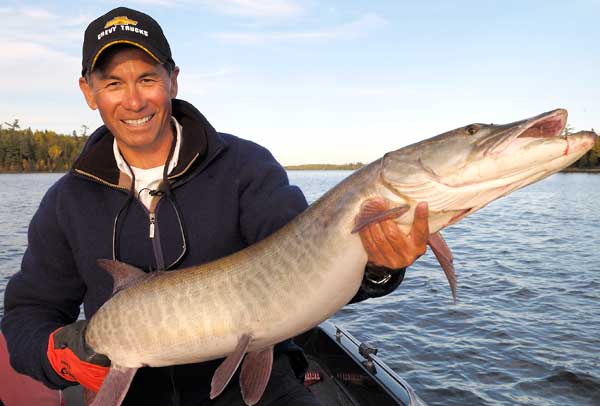 |


